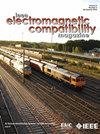利用双端开路短节抑制弯曲共面波导的耦合槽线模式
IF 2
3区 计算机科学
Q3 ENGINEERING, ELECTRICAL & ELECTRONIC
IEEE Transactions on Electromagnetic Compatibility
Pub Date : 2025-01-23
DOI:10.1109/TEMC.2025.3529296
引用次数: 0
摘要
本文采用双端开路短管抑制弯曲共面波导中的耦合槽线模式。研究了三种结构:较短的槽线补偿结构;CSL模式滤波器结构;混合结构。较短的槽线补偿结构将双端开路存根置于共面波导较短的槽线下方,以补偿共面波导较短和较长的槽线之间的相位差。由此产生的CSL模式转换从dc到12.5 GHz小至- 15 dB。CSL模式滤波器结构将双端开路存根置于共面波导的较短和较长的槽线下,以产生共面波导CSL模式的谐振频率为12.5 GHz。由此产生的CSL模式转换在12.5 GHz到20 GHz之间小至- 15 dB。通过集成较短的槽线补偿结构和CSL模式滤波器结构,混合结构产生的CSL模式转换从dc到20 GHz可小至- 20 dB。进一步提高了共面波导模式的信号完整性。本文章由计算机程序翻译,如有差异,请以英文原文为准。
Coupled Slotline Mode Suppression for Bent Coplanar Waveguide Using Double-Ended Open-Circuited Stubs
This article applies the double-ended open-circuited stubs to suppress the coupled slotline (CSL) mode in the bent coplanar waveguide. Three structures are investigated: the shorter slotline compensation structure; the CSL mode filter structure; and the hybrid structure. The shorter slotline compensation structure places the double-ended open-circuited stubs underneath the shorter slotline of the coplanar waveguide to compensate for the phase difference between the shorter and longer slotlines of the coplanar waveguide. The resulting CSL mode conversion is as small as −15 dB from dc to 12.5 GHz. The CSL mode filter structure places the double-ended open-circuited stubs underneath both the shorter and longer slotlines of the coplanar waveguide to generate a resonant frequency for the CSL mode of the coplanar waveguide at 12.5 GHz. The resulting CSL mode conversion is as small as −15 dB from 12.5 GHz to 20 GHz. By integrating the shorter slotline compensation structure and the CSL mode filter structure, the hybrid structure's resulting CSL mode conversion can be as small as −20 dB from dc to 20 GHz. Furthermore, the signal integrity of the coplanar waveguide mode is improved.
求助全文
通过发布文献求助,成功后即可免费获取论文全文。
去求助
来源期刊
CiteScore
4.80
自引率
19.00%
发文量
235
审稿时长
2.3 months
期刊介绍:
IEEE Transactions on Electromagnetic Compatibility publishes original and significant contributions related to all disciplines of electromagnetic compatibility (EMC) and relevant methods to predict, assess and prevent electromagnetic interference (EMI) and increase device/product immunity. The scope of the publication includes, but is not limited to Electromagnetic Environments; Interference Control; EMC and EMI Modeling; High Power Electromagnetics; EMC Standards, Methods of EMC Measurements; Computational Electromagnetics and Signal and Power Integrity, as applied or directly related to Electromagnetic Compatibility problems; Transmission Lines; Electrostatic Discharge and Lightning Effects; EMC in Wireless and Optical Technologies; EMC in Printed Circuit Board and System Design.

 求助内容:
求助内容: 应助结果提醒方式:
应助结果提醒方式:


